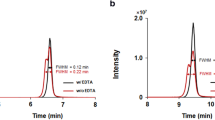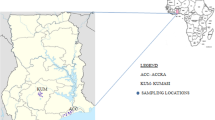Abstract
Matrix certified reference materials (CRMs) are an indispensable part of method validation and have played an important role in ensuring reliable analytical results. To retain similarity to real samples, a new matrix CRM for the mass fraction of ciprofloxacin in whole liquid egg was developed by use of incurred materials with a target value corresponding to residue levels in real sample. The source materials were collected from laying hens following oral administration of ciprofloxacin. An optimized homogenization method and a strict bottling process were applied to bulk whole egg materials to prepare the CRM candidate. The mass fraction of ciprofloxacin in whole liquid egg was certified by a collaborative characterization program with eight accredited participating laboratories. Liquid chromatography coupled with isotope dilution mass spectrometry was studied as a reliable reference method for value assignment and was used by all participating laboratories. The certified value and expanded uncertainty (k = 2, at a confidence level of 95%) was 39.7 ± 5.2 μg/kg for ciprofloxacin in whole liquid egg. Homogeneity, long-term stability at -70 °C for 12 months, and short-term stability at -18 °C, 4 °C, and room temperature were assessed for 9 days. Additionally, uncertainties arising from inhomogeneity, instability, and characterization were analyzed in detail and fully estimated. This CRM would be a useful tool for validation of analytical methods and proficiency testing in ciprofloxacin residue analysis of egg.

Graphical Abstract





Similar content being viewed by others
References
Bonassa KPD, Miragliotta MY, Simas RC, Monteiro DA, Eberlin MN, Anadon A, et al. Tissue depletion study of enrofloxacin and its metabolite ciprofloxacin in broiler chickens after oral administration of a new veterinary pharmaceutical formulation containing enrofloxacin. Food Chem Toxicol. 2017;105:8–13.
Fanning S, Wang J, Leonard N. Veterinary drugs residues: antibacterials. In: Motarjemi Y, editor. Encyclopedia of food safety, vol. 3. Amsterdam: Elsevier Inc.; 2014. pp. 39–44.
Santos L, Ramos F. Analytical strategies for the detection and quantification of antibiotic residues in aquaculture fishes: a review. Trends Food Sci Technol. 2016;52:16–30.
Lee HC, Chen CM, Wei JT, Chiu HY. Analysis of veterinary drug residue monitoring results for commercial livestock products in Taiwan between 2011 and 2015. J Food Drug Anal. 2018;26(2):565–71.
Pereira A, Silva LJG, Rodrigues J, Lino C, Pena A. Risk assessment of fluoroquinolones from poultry muscle consumption: comparing healthy adult and pre-school populations. Food Chem Toxicol. 2018;118:340–7.
Gorla N, Garcia Ovando H, Larripa I. Chromosomal aberrations in human lymphocytes exposed in vitro to enrofloxacin and ciprofloxacin. Toxicol Lett. 1999;104(1-2):43–8.
Hanna N, Sun P, Sun Q, Li X, Yang X, Ji X, et al. Presence of antibiotic residues in various environmental compartments of Shandong province in eastern China: its potential for resistance development and ecological and human risk. Enviro Int. 2018;114:131–42.
Liu X, Steele JC, Meng XZ. Usage, residue, and human health risk of antibiotics in Chinese aquaculture: a review. Environ Pollut. 2017;223:161–9.
Wang H, Ren L, Yu X, Hu J, Chen Y, He G, et al. Antibiotic residues in meat, milk and aquatic products in Shanghai and human exposure assessment. Food Control. 2017;80:217–25.
Jiménez V, Companyó R, Guiteras J. Validation of a method for the analysis of nine quinolones in eggs by pressurized liquid extraction and liquid chromatography with fluorescence detection. Talanta. 2011;85(1):596–606. https://doi.org/10.1016/j.talanta.2011.04.021.
Bogialli S, D'Ascenzo G, Di Corcia A, Lagana A, Tramontana G. Simple assay for monitoring seven quinolone antibacterials in eggs: extraction with hot water and liquid chromatography coupled to tandem mass spectrometry. Laboratory validation in line with the European Union Commission Decision 657/2002/EC. J Chromatogr A. 2009;1216(5):794–800.
Lu Z, Deng F, He R, Tan L, Luo X, Pan X, et al. A pass-through solid-phase extraction clean-up method for the determination of 11 quinolone antibiotics in chicken meat and egg samples using ultra-performance liquid chromatography tandem mass spectrometry. Microchem J. 2019;151:104213.
Hassouan MK, Ballesteros O, Taoufiki J, Vilchez JL, Cabrera-Aguilera M, Navalon A. Multiresidue determination of quinolone antibacterials in eggs of laying hens by liquid chromatography with fluorescence detection. J Chromatogr B. 2007;852(1-2):625–30.
Olivares IRB, Souza GB, Nogueira ARA, Toledo GTK, Marcki DC. Trends in developments of certified reference materials for chemical analysis - focus on food, water, soil, and sediment matrices. Trends Anal Chem. 2018;100:53–64.
Yarita T, Takatsu A, Inagaki K, Numata M, Chiba K, Okamoto K. Matrix certified reference materials for environmental monitoring from the National Metrology Institute of Japan (NMIJ). Accredit Qual Assur. 2006;12(3-4):156–60.
Ricci M, Lava R, Koleva B. Matrix certified reference materials for environmental monitoring under the EU Water Framework Directive: an update. Trends Anal Chem. 2016;76:194–202.
Krska R, Welzig E. Certified reference materials and proficiency testing. Anal Bioanal Chem. 2003;376(3):316–8.
International Organization for Standardization. ISO 17034:2016. General requirements for the competence of reference material producers. 201.
International Organization for Standardization. ISO Guide 35:2017. Reference materials – guidance for characterization and assessment of homogeneity and stability. 2017.
Phillips MM, Sharpless KE, Wise SA. Standard reference materials for food analysis. Anal Bioanal Chem. 2013;405(13):4325–35.
Wise SA, Phillips MM. Evolution of reference materials for the determination of organic nutrients in food and dietary supplements—a critical review. Anal Bioanal Chem. 2019;411(1):97–127.
Johnston L, Croft M, Murby J, Shearman K. Preparation and characterisation of certified reference materials for furazolidone and nitrofurazone metabolites in prawn. Accredit Qual Assur. 2015;20(5):401–10.
Hyung SW, Lee CH, Kim B. Development of certified reference materials for accurate determination of fluoroquinolone antibiotics in chicken meat. Food Chem. 2017;229:472–8.
Zeleny R, Schimmel H, Ulberth F, Emons H. Development of a certified reference material for the content of nitroimidazole parent drugs and hydroxy metabolites in pork meat. Anal Chim Acta. 2009;634(2):237–42.
Xu JJ, Chen Q, Cai ZX, Ren YP, Zhao YF, Cheng J, et al. A feasibility study of producing a peanut oil matrix candidate reference material and its application to support monitoring of aflatoxins statues for public health purposes. Food Chem. 2018;268:395–401.
Otake T, Yarita T, Aoyagi Y, Kuroda Y, Numata M, Iwata H, et al. Development of green onion and cabbage certified reference materials for quantification of organophosphorus and pyrethroid pesticides. J Agric Food Chem. 2011;59(16):8568–74.
Jiménez V, Companyó R, Guiteras J. Analysis of quinolone antibiotics in eggs: preparation and characterization of a raw material for method validation and quality control. Food Chem. 2012;134(3):1682–90.
Violante FGM, de Oliveira Rosas C, de Freitas Guimarães E, de Carvalho Vital H, Zúniga NOC, de Aquino Neto FR. Feasibility study for the development of a certified reference material of nitrofuran metabolites in chicken breast muscle from incurred samples. Measurement. 2018;129:368–74.
Wang Z, Wang X, Tian H, Wei Q, Liu B, Bao G, et al. High through-put determination of 28 veterinary antibiotic residues in swine wastewater by one-step dispersive solid phase extraction sample cleanup coupled with ultra-performance liquid chromatography-tandem mass spectrometry. Chemosphere. 2019;230:337–46.
Christodoulou EA, Samanidou VF, Papadoyannis IN. Validation of an HPLC-UV method according to the European Union Decision 2002/657/EC for the simultaneous determination of 10 quinolones in chicken muscle and egg yolk. J Chromatogr B. 2007;859(2):246–55.
Acknowledgements
The authors gratefully acknowledge financial support from the National Key Research and Development Program of China (2016YFF0201105) and the Agricultural Science and Technology Innovation Program of China.
Author information
Authors and Affiliations
Corresponding author
Ethics declarations
All animal experiments were approved by the Animal Care and Ethics Committee of Nanjing Agricultural University (permit number IACECNAU20111105) and followed the Guiding Principles for Biomedical Research Involving Animals.
Conflict of interest
The authors declare that they have no competing interests.
Additional information
Publisher’s note
Springer Nature remains neutral with regard to jurisdictional claims in published maps and institutional affiliations.
Electronic supplementary material
ESM 1
(PDF 445 kb)
Rights and permissions
About this article
Cite this article
Yang, M., Liu, F., Wang, M. et al. New matrix certified reference material for accurate measurement of ciprofloxacin residue in egg. Anal Bioanal Chem 412, 635–645 (2020). https://doi.org/10.1007/s00216-019-02264-5
Received:
Revised:
Accepted:
Published:
Issue Date:
DOI: https://doi.org/10.1007/s00216-019-02264-5




